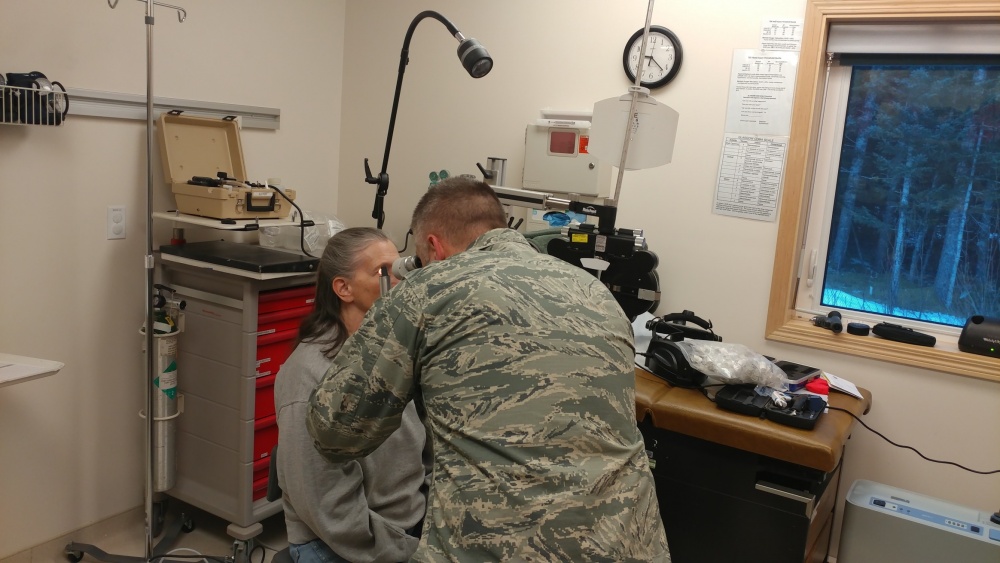 Photo By Tech. Sgt. Wendy Day | Air Force Major Brett Ringger, 136th Medical Group, Texas Air National Guard, provide eye exams in a portable optometry clinic during ARCTIC CARE 2017, Port Lions, Alaska, March 28, 2017. ARCTIC CARE 2017 is part of the Innovative Readiness Training program, which is an Office of Secretary of Defense sponsored civil-military collaboration intended to build on mutually beneficial partnerships between U.S. communities and the Department of Defense. ARCTIC CARE 2017 provides training opportunities for U.S. military (Active, Guard, Reserve) and Canadian Health service members to prepare for worldwide deployment while supporting the needs of underserved communities on Kodiak Island, Alaska. (U.S. Air Force photo by Tech. Sgt. Wendy Day)
Photo By Tech. Sgt. Wendy Day | Air Force Major Brett Ringger, 136th Medical Group, Texas Air National Guard, provide eye exams in a portable optometry clinic during ARCTIC CARE 2017, Port Lions, Alaska, March 28, 2017. ARCTIC CARE 2017 is part of the Innovative Readiness Training program, which is an Office of Secretary of Defense sponsored civil-military collaboration intended to build on mutually beneficial partnerships between U.S. communities and the Department of Defense. ARCTIC CARE 2017 provides training opportunities for U.S. military (Active, Guard, Reserve) and Canadian Health service members to prepare for worldwide deployment while supporting the needs of underserved communities on Kodiak Island, Alaska. (U.S. Air Force photo by Tech. Sgt. Wendy Day)
KODIAK ISLAND, AK, UNITED STATES
04.11.2017
Story by: Staff Sgt. Kristina Overton
136th Airlift Wing (Texas Air National Guard)
The mission of the Texas Air National Guard involves not only assisting individuals within the state, but also a nation-wide outreach effort to provide relief and care for citizens throughout the country. When called, guardsmen are equipped to travel coast-to-coast to offer services when needed.
On March 28, the need was forged in Kodiak, Alaska, and Maj. Brett Ringger, 136th Medical Group optometry officer in charge, deployed in support of an Innovative Readiness Training mission on the island.
“I took part in ARCTIC CARE 2017, a joint services mission to provide care to the underserved community of Kodiak, Alaska, and its surrounding villages of Old Harbor, Port Lions, Ouzinkie, Akhiok, Larsen Bay, and Karluk,” said Ringger. “I was in a village location, Port Lions. It is a community of about 120-125 people and is accessible only by airlift or water.”
The Alaska Air Force Reserve provided Blackhawk support and airlifted equipment and staff to the village airstrip. Despite the geographical challenges, Ringger and his team were able to set up their facilities to assist the community.
“I was the optometrist for the team and performed 34 exams, approximately a quarter of the village population,” Ringger said. “I also served as officer in charge for the Port Lions location and was responsible for our team of 17 service members across the guard and reserve, Navy, Army, and Marine components. I was ultimately accountable for tracking patients and training hours, inventory, repacking equipment and supplies, and reporting to the Tactical Operations Center.”
ARCTIC CARE 2017 is an Air Force Reserve Command led event coordinated with Kodiak Area Native Association (KANA) and civil authorities to provide medical, dental, optometry, and veterinary care for communities in the area at no cost to the patient. The exercise included active-duty, guard and reserve units and allowed for service members to hone their abilities to set up and utilize medical equipment in deployed environments.
“It’s vital to have the opportunity to train with the actual equipment that we would work with in a deployed environment to an austere location,” Ringger said. “For example, in a static optometry clinic we have automated equipment that measures the prescription in members' glasses, eye pressure, and approximate refraction. We had the ability to do all of these things with the portable equipment we use on deployments, which is much different in operation and mostly uses analog as opposed to automated. I was able to train the optometry tech assigned to perform all of the necessary tests on equipment she had never seen before. She is now proficient in being a part of a deployable optometric team.”
With multiple services involved in making ARCTIC CARE 2017 a successful operation, teamwork was paramount in the overall mission. For Ringger, being able to work with different units was a major highlight of the experience.
“I really enjoyed getting to know my team,” Ringger said. “They all had a unique perspective that added to the mission and I appreciated how well we all worked together to complete the mission, and most importantly, to care for the people we came to serve. I loved interacting with the local folks and feel like this experience has been very enriching to me both personally and in my military service.”
As Ringger traveled back to his unit, he had several takeaways from his participation in ARCTIC CARE 2017, but the ability to train and provide services to citizens like those on Kodiak Island was one he said he could never forget and an exercise he would recommend.
“It is great training to be forced to problem-solve and remedy things when they go sideways before something similar happens downrange,” Ringger concluded. “Alaska is a beautiful place and in our village, the locals made us feel right at home, as if we were already family. They were so appreciative of why we were there and were willing to help us in any way. The icing on the cake was to be able to provide care for appreciative people who may not otherwise have access to the care that they need.”
The exercise ended on April 6, 2017.
For more information about members of the 136th Airlift Wing, visit http://www.136aw.ang.af.mil.